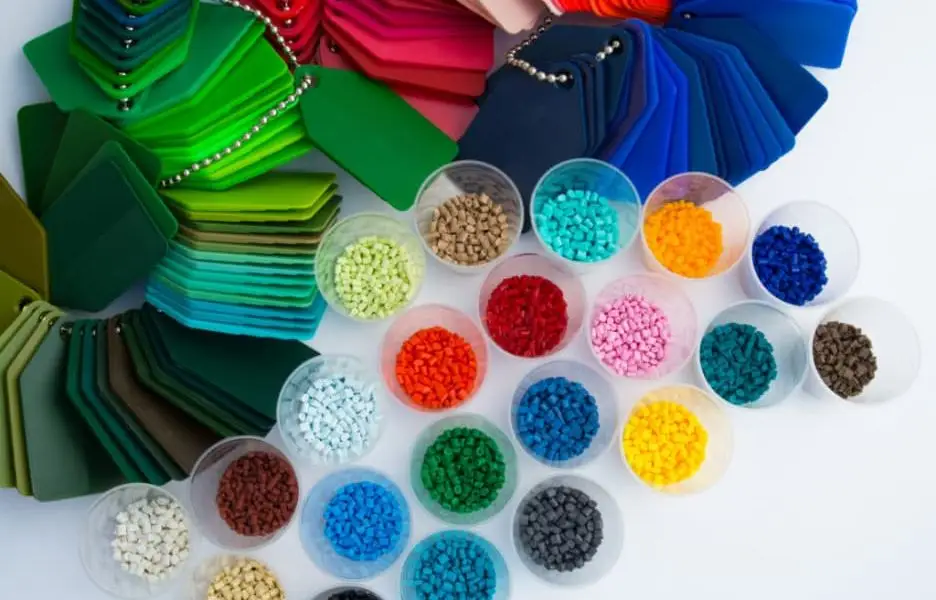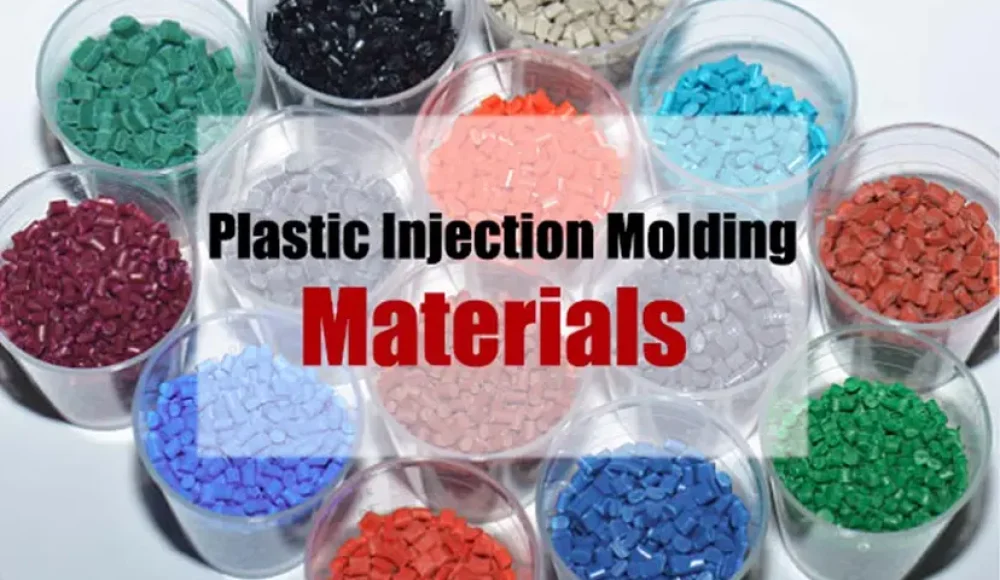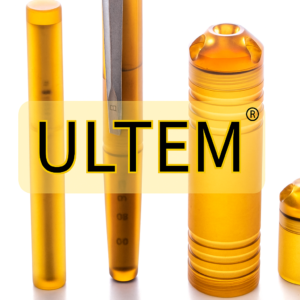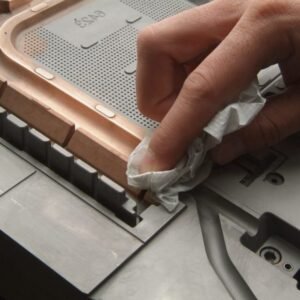La sélection du matériau approprié est l'une des étapes les plus critiques de conception de moulage par injection. Le choix de la résine thermoplastique détermine non seulement la résistance mécanique et la durabilité d'une pièce moulée mais également sa fabricabilité., état de surface, coût, et fiabilité à long terme.
Ce guide fournit aux ingénieurs et aux concepteurs un cadre structuré pour évaluation quantitative des matériaux de moulage par injection. Il se concentre sur la mécanique clé, thermique, et propriétés chimiques qui influencent les performances, vous aidant à sélectionner la résine optimale pour votre application spécifique.
Introduction

matériaux de moulage par injection plastique
Choisir un résine thermoplastique pour moulage par injection peut être une décision d’ingénierie complexe. Chaque famille de polymères présente des caractéristiques uniques qui réagissent différemment aux charges mécaniques, variations de température, et les conditions environnementales. Pour faire une sélection sonore, les ingénieurs doivent comprendre la relation entre structure et performances des matériaux, ainsi que les exigences spécifiques de l'application.
Pour les applications critiques en matière de sécurité, haute performance, ou des composants sensibles à la fiabilité, une analyse approfondie analyse technique est obligatoire. Cela inclut l’évaluation du stress, souche, et l'exposition environnementale pour déterminer quel matériau répond à toutes les exigences opérationnelles.
Cependant, tous les projets ne nécessitent pas de simulation ou de tests approfondis. De nombreux composants moulés fonctionnent dans des conditions douces, telles que la température ambiante et de faibles charges, où les résines courantes comme l'ABS, polypropylène (PP), ou polycarbonate (PC) sont plus que suffisants. Pour de tels cas, directives simplifiées – abordées plus loin dans ce guide sous "Ne m'oblige pas à faire le calcul"— peut aider les non-ingénieurs à prendre des décisions matérielles pratiques et rentables.
Pourquoi la sélection des matériaux est importante
La sélection des matériaux devient souvent un jeu de devinettes quand il y a un manque de compréhension:
Comment la structure interne du polymère affecte les propriétés.
Comment définir clairement les exigences des applications réelles.
Où trouver des données fiables et comparables pour les matériaux candidats.
Même de petites variations dans la composition de la résine ou dans les paramètres de traitement peuvent affecter considérablement résistance à la traction, stabilité dimensionnelle, ou résistance aux chocs. Donc, une sélection éclairée des matériaux garantit une qualité constante, rentabilité, et des performances prévisibles tout au long du cycle de vie d’un produit.
Comparaison des matériaux de moulage par injection courants
| Type de résine | Avantages clés | Applications typiques | Considérations de conception |
| POM (Acétal) | Difficile, rigide, fort, faible frottement, résistant à la fatigue | Engrenages, pompes, échange, interrupteurs, boutons | Sensible au retrait; difficile à peindre ou à enduire |
| PMMA (Acrylique) | Excellente clarté, résistant aux rayures, faible retrait | Lentilles, signes, conduits de lumière | Fragile, mauvaise résistance chimique |
| abdos | Difficile, résistant aux produits chimiques, dimensionnellement stable, faible coût | Boîtiers électroniques, appareils portables, pièces cosmétiques | Peut montrer des lignes de tricot; les sections épaisses peuvent couler |
| PEHD | Difficile, impact- et résistant aux produits chimiques, léger | Conteneurs, jouets, meubles | Retrait élevé, faible énergie de surface |
| PC (Polycarbonate) | Haute résistance, clarté, et résistance à l'impact | Lentilles, éclairage, logements, verre pare-balles | Mauvaise résistance chimique; peut bouillonner dans les parties épaisses |
| Mélange ABS/PC | Bon équilibre entre ténacité et aptitude au traitement | Automobile, électronique | Coût inférieur à celui du PC; propriétés de moulage améliorées |
| PP (Polypropylène) | Flexible, résistant à la fatigue, résistant aux produits chimiques | Charnières, casquettes, tube médical | Rétrécissement et déformation possibles; peut vider dans les zones épaisses |
| COUP D'OEIL | Résistance aux hautes températures et aux produits chimiques | Aérospatial, pompes, Équipement médical | Très cher; Ultem ou PPSU sont des alternatives moins chères |
| Î.-P.-É. (Ultem) | Fort, résistant à la chaleur, dimensionnellement stable | Médical, éclairage, Composants CVC | Cher, mais moins cher que le PEEK |
| PPSU | Tolérance élevée à la chaleur et aux produits chimiques, stérilisable | Plateaux médicaux, intérieurs d'avions | Les sections épaisses peuvent vider; options de couleurs limitées |
| Pennsylvanie (Nylon) | Haute résistance, résistance à l'abrasion | Engrenages, bagues, pièces structurelles | Absorbe l'humidité; peut se déformer |
| PBT/PET | Excellentes propriétés électriques et dimensionnelles | Appareils, automobile, électrique | Sujet à la déformation dans les qualités remplies de verre |
| PCL | Haut débit, résistance chimique, faible dilatation thermique | Connecteurs, PCBS | Cher, retrait anisotrope |
| PPS | Haute résistance chimique et thermique | Automobile, boîtiers électriques | Nécessite un contrôle précis de la cristallisation |
À propos de la fiche technique du matériau standard
UN fiche technique du matériau fournit des propriétés mécaniques et thermiques essentielles, généralement mesurées à température ambiante. Même si ces valeurs (par exemple., résistance à la traction, élongation, module de flexion) sont importants, ils décrivent souvent des conditions de défaillance plutôt que des performances réelles. Les ingénieurs doivent donc interpréter attentivement les fiches techniques, compte tenu des conditions environnementales, géométrie en partie, et charges attendues.
Plus que 85,000 plastiques commerciaux exister, regroupés autour 45 familles de polymères. Les thermoplastiques dominent la fabrication moderne, représentant environ 85% de toute utilisation de plastique, tandis que les thermodurcis constituent le reste 15%. Les informations supplémentaires provenant des fournisseurs, comme les manuels de conception et les études de cas, peuvent aider à combler les lacunes en matière de données pour les matériaux de qualité technique..
Parfait 👍 Continuons et complétons le version réécrite et optimisée pour le référencement de votre article - reprenant là où il s'était arrêté ("Ne m'oblige pas à faire le calcul!") et le terminer avec un fort, fin éducative qui correspond à votre style d’écriture technique SEO.
Ne m'oblige pas à faire le calcul!
De nombreux tableaux de propriétés matérielles affichent des ratios tels que rapport résistance/poids ou rigidité/coût, mais dans une conception de moule pratique, peu d'ingénieurs ont le temps d'analyser ces chiffres manuellement. Plutôt, la meilleure pratique est de créer une liste restreinte de matériaux viables basé sur des exigences mécaniques et thermiques, alors comparer spécifique, propriétés du monde réel (par exemple., résistance à la traction à la température de fonctionnement, taux de retrait, et écoulement de fonte).
Les bases de données de matériaux en ligne et les fiches techniques des fournisseurs rendent cela plus facile que jamais. Un simple filtrage selon votre plage de performances peut réduire des centaines de résines à une poignée de candidats.. Une fois que cette liste restreinte est prête, ton mouleur ou distributeur de résine peut fournir des données de test détaillées pour la validation et les essais de pièces.
Conseil de pro: Testez toujours avec le exact qualité de résine que vous envisagez d'utiliser en production — même de petites différences dans les additifs, teneur en humidité, ou les formulations des fournisseurs peuvent modifier considérablement le comportement d'écoulement et de retrait.
Tests et validation: Ne sautez jamais cette étape
La sélection des matériaux ne s'arrête pas à la fiche technique. Après avoir identifié un ou deux candidats prometteurs, tests de prototypes est essentiel. Construire un petit moule pilote, exécuter des plans courts, et inspecter les fonctionnalités critiques. Cela révèle comment la matière circule, remplit, et les déformations dans la géométrie réelle de votre pièce : des informations que les simulations ne peuvent pas toujours prédire.
Les contrôles de validation typiques incluent:
Précision dimensionnelle — Comparez les dimensions mesurées avec les données CAO.
Finition de surface — Confirmer la réplication de la texture et les niveaux de brillance.
Essais mécaniques — Évaluer la traction, impact, et performances en fatigue.
Résistance environnementale — Test contre les produits chimiques, Exposition aux UV, ou cycles de température.
En détectant tôt les problèmes liés au matériel, vous pouvez éviter des refontes coûteuses ou des réclamations au titre de la garantie plus tard.
Collaborez avec votre expert en moulage
Même les ingénieurs concepteurs les plus expérimentés bénéficient de la collaboration avec un mouleur expérimenté lors de la sélection des matériaux. Les concepteurs de moules et les ingénieurs de procédés peuvent vous conseiller sur:
Approprié choix d'acier de moule pour correspondre à l'abrasivité de la résine ou aux tendances à la corrosion.
Le besoin de revêtements de moules ou compatibilité des canaux chauds pour matériaux difficiles.
Ajustement placement de la porte, ventilation, et angles de dépouille pour des propriétés d'écoulement de résine spécifiques.
Leur connaissance de la production conduit souvent à une meilleure cohérence à long terme et à moins de problèmes de traitement, ce qui permet d'économiser du temps et de l'argent..
Considérations sur la durabilité et le recyclage
L’environnement manufacturier actuel met de plus en plus l’accent sur la durabilité. Lorsque cela est possible, considérer matériaux recyclés ou biosourcés. De nombreux fournisseurs de résine proposent désormais RAP (Recyclé post-consommation) ou bio-résine versions de polymères standards tels que le PP, ANIMAL DE COMPAGNIE, et PA.
Bien que ces options durables puissent légèrement modifier les propriétés mécaniques ou de couleur, ils contribuent à réduire l’impact environnemental et soutiennent les initiatives de produits plus écologiques. Testez toujours ces matériaux dans des conditions de traitement réelles pour garantir une qualité constante.
Pensées finales
Choisir le bon matériau de moulage par injection est l'un des décisions les plus importantes en conception de pièces. La résine que vous choisissez détermine non seulement la résistance et les performances du produit, mais également coût, durabilité, et fabricabilité.
Voici un résumé rapide pour guider votre processus:
Définissez vos besoins - force, température, exposition chimique, apparence, et le coût.
Matériaux de présélection qui correspondent à votre gamme de propriétés.
Évaluer la compatibilité des processus — retrait, sensibilité à l'humidité, moulabilité.
Prototyper et valider avant la sélection finale.
Consultez votre mouleur pour affiner les paramètres de production.
Une réflexion, L'approche basée sur les données garantit que chaque composant moulé répond aux objectifs de performance et aux attentes budgétaires - la base d'une fiabilité, production reproductible.
Suggestions de liens internes (pour WordPress)
Guide de moulage par injection de nylon
Guide de conception des angles de dépouille
13 Types de finitions de surface en moulage sous pression
Guide de conception des nervures en plastique




1 réfléchi à "Guide de sélection des matériaux de moulage par injection”